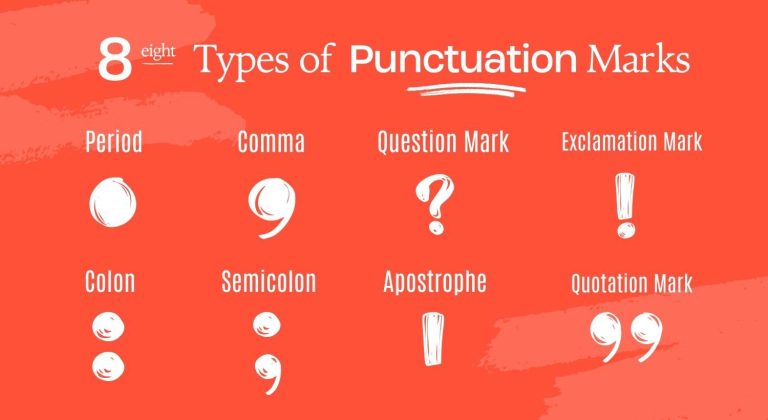8 Types of Punctuation Marks

Punctuation marks are like traffic lights for writing. They help us understand and organize our sentences. Each one, from the period to the exclamation mark, has its job. This article will explore the different types of punctuation marks and how they guide us in writing.
The Period
Periods (.) end sentences. They’re like a stop sign. Periods signal a full stop, giving us a chance to take a breath. They help keep our writing clear, ensuring each thought has its own space.
We also use periods in abbreviations. They show shortening, like “Dr.” for Doctor. They also appear in dates and email addresses, acting as separators. Periods are small but mighty. This is because they control the rhythm of our sentences.
Here’s an example using a period. This sentence ends with a period. It signals a complete thought and a full stop.
“He finished his homework.”
The Comma
Commas (,) take a small pause. They’re like a yield sign. Commas are like breaths in a sentence. They let us pause just enough in a sentence.
Commas help us list things. For example, “We have apples, bananas, and oranges.” They also jump in to separate extra information not part of the main idea.
The example sentence below uses a comma. This sentence uses a comma to separate the introductory phrase from the main clause, indicating a brief pause.
“After dinner, we went for a walk.”
The Colon
Colons (:) introduce lists or explanations. They act as a spotlight, highlighting what comes next. For example, it could be a list, a quote, or an explanation.
Colons prepare the reader for a reveal, much like a drumroll before the big moment. In writing, colons connect two related parts, where the second part explains or expands on the first. They’re especially useful in titles.
Here’s an example using a colon. This sentence uses a colon to introduce an explanation of her goal, highlighting the specific ambition she holds.
“She has one goal in life: to become a doctor.”
The Semicolon
Semicolons (;) link two related ideas together. They’re like a bridge between thoughts. They allow readers to pause slightly longer than a comma would.
We use semicolons as a smoother transition than a period. They’re perfect for contrasting ideas that are equal in rank. In complex lists, semicolons organize items that already contain commas.
The example sentence below uses a semicolon. This sentence uses a semicolon to connect two related thoughts. It shows not only what he loves but also highlights his favorite subject.
“He loves reading about science; it’s his favorite subject.”
The Question Mark
Question marks (?) show that someone is seeking information. They turn sentences into inquiries, signaling that someone is asking something and waiting for a reply.
With a simple curve and dot, question marks transform the tone of words. Just like the ones in question tags. They can also express uncertainty, such as using them in parentheses (?).
Here’s an example that demonstrates the use of a question mark. This sentence uses a question mark to indicate that an answer or response is expected.
“Are you going to the party tonight?”
The Exclamation Mark
Exclamation marks (!) show excitement or surprise. Like a horn honking, exclamation marks inject energy into sentences. We use them to express feelings like joy, anger, or shock.
In dialogue, exclamation marks convey emphasis, showing that a character is shouting or excited. Too many exclamation marks, however, can overwhelm readers. It also makes the text seem less serious.
The example sentence below uses two exclamation marks. It uses an exclamation mark to express enthusiasm about how good the movie was.
“Wow! That movie was incredible!”
The Apostrophe
Apostrophes wear two hats in the world of writing. They show possession, linking things to their owners. For example, “Jessica’s book” tells us the book belongs to Jessica.
Secondly, we also use them for contraction. They squeeze words together by omitting letters, like turning “do not” into “don’t.” With a simple flick, apostrophes keep the meaning of our sentences clear.
Here’s an example showing an apostrophe for a contraction. This sentence shows a contraction by shortening “Jenny is” to “Jenny’s”. The missing letter “i” in the contraction of “is going.”
“Jenny’s going to the park.”
Quotation Marks
Quotation marks (” “) wrap around words someone says. It’s like replaying a voice without changing any of the words. Using quotation marks ensures what is quoted is accurate.
Beyond dialogue, quotation marks also highlight titles of articles, songs, and poems. This helps set them apart from the rest of the text. Sometimes, we use them to show irony, emphasis, and even sarcasm.
The example sentence below uses quotation marks. As you can see, this sentence uses quotation marks to show exactly what Alice said. It’s like playing back her voice in writing.
Alice said, “I can’t wait for the weekend.”
Types of Punctuation Marks
Punctuation marks are essential in writing. They guide us, like traffic signals, ensuring our ideas flow smoothly and clearly.
From periods that signal a full stop to commas that offer a pause, each punctuation mark has a special role.
Did we miss any types of punctuation marks? Please let us know in the comment section below.
